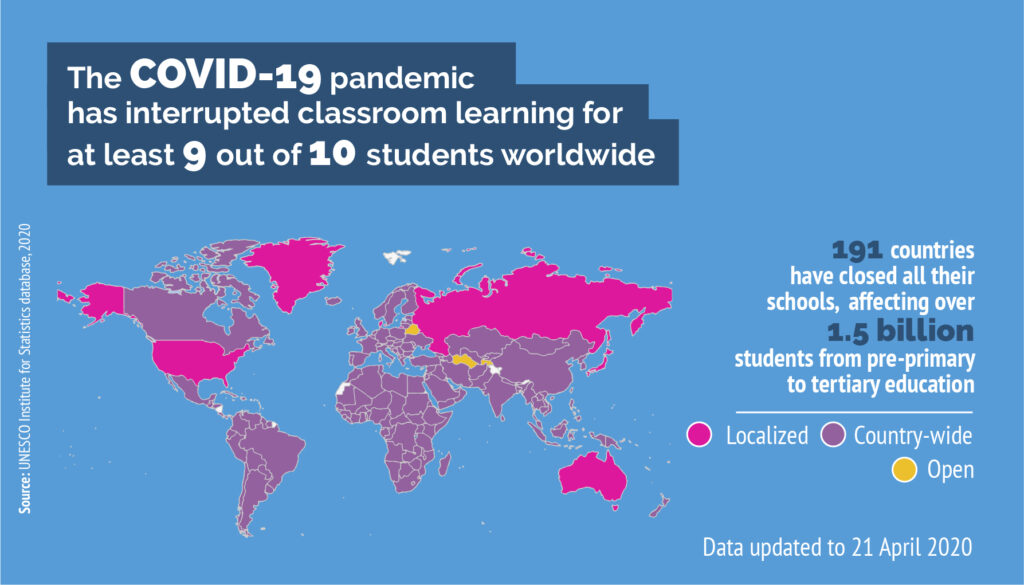Despite its recent rapid expansion in education, online learning is nothing new. This article will look at the state of online learning today, its advantages and disadvantages, and its role in the future.
Online education had been due its time to shine for many years, but nobody expected it to come so suddenly and globally as it did during the almost worldwide lockdown.
Pre-lockdown, many schools and higher education institutions had been experimenting with online features but this often led to education bowing to support technology, not technology supporting education.

UNESCO.
When the coronavirus crisis forced much of the world online, most campus-based schools were utterly unprepared. They had to cobble together software, hardware and people to create makeshift courses that seriously disrupted learning. This has been the push that has finally caused schools to look for longtime associations with technological partners.
One of the reasons for the lack of preparation lies with how slowly national education systems can move. Passing innovations through the ministry of education, then implementing them in schools takes time and many opportunities are missed because of this slow process. Schools with more autonomy, such as private schools, can make decisions more quickly and adapt to new technology at a faster rate.
However, there were many online higher education institutions, like the Swiss School of Business Research, that rode the wave seamlessly. From its very creation, it made online learning a cornerstone of its philosophy, and designed its courses in line with technology. This prior preparation left the school untouched by the crisis, and its students were able to carry on as normal.
Now, in 2020, there are all kinds of reasons students would choose online over on-campus – and it’s not just to stay safe. Below, you can find a list of the top reasons students choose online learning.
1. More affordable courses
Renting – and especially buying – a premises to host a university is incredibly expensive, and naturally it’s the students who indirectly pay those costs. By moving everything online, a large chunk of the course costs are removed, meaning more of your money goes directly to your education.
2. Cheaper living costs
Moving out of home, to a new city, or even to a new country to study doesn’t come cheap. With travel to your destination, rent, bills and food, things quickly start adding up. The luxury of living at home means that once you have a good internet connection, you’re all set.

Scenes like this can be easily avoided with online learning. Photo by Corey Agopian on Unsplash
3. Commute? What commute?
Studying from home cuts your commute to zero, freeing up hours in your day to be spent more productively, like exercising or cooking. It’s not just you who benefits from this either. During the first coronavirus lockdown, pollution dropped drastically all over the world as transport systems shut down and cars remained in their garages.
4. The democratization of learning
Expensive courses in expensive cities means a huge chunk of the global population simply can’t pay for top-tier education.
What’s more, many students are rejected based entirely on their visa. With a remote learning format, students from all over the world can study without having to jump through this laborious hoop.
As part of the SSBR Vision and Mission, we are committed to making Swiss quality education accessible to as many people as possible.
5. Worldwide networking
As virtual classrooms welcome students from every corner of the globe, students get invaluable exposure to all kinds of cultures, backgrounds and points of view. This prepares students as they move into an ever-more international world of business and opens their mind to global opportunities.
6. Prepare for an online marketplace
Offices have emptied and homes have filled, with Spain even ruling that workers must work from home if possible. Clearly, not everybody was ready for the switch to a brand-new working environment.
On the flip side, students who have completed an entire degree online will always have an edge in terms of tools like Zoom, shared documents and much more.
7. Study on your own schedule
Most online courses are taught through webinars, online projects and virtual lectures, giving students a lot of flexibility when they study. This is especially important for parents, or those who need their studies to fit around work.
8. Learn valuable transferable skills
With remote learning, it’s not just what you learn, it’s how you learn. People who study online pick up habits and skills you wouldn’t even think about, like time management, autonomy, personal well being and much more. And these are the transferable skills that make you a reliable, efficient worker once your studies are over.
So what are the drawbacks?
One of the common issues found with remote learning is that students cannot truly bond without being on campus together. And yes, it’s true that there is no replacement for face-to-face contact, but as this crisis has proven, it doesn’t take long for people to make strong connections online.

The coronavirus crisis has normalized online interaction. Photo by Chris Montgomery on Unsplash
Similarly, a lack of teacher feedback is used as a common criticism. However, this is more an issue in the course design, rather than the essence of online learning. There are plenty of ways for teachers to give full, detailed feedback, whether through dedicated apps or by simply arranging a video call.
Another potential pitfall is the lack of accreditation in e-learning. This is a valid concern, as many online learning platforms appear with no formal recognition behind them. As is often the case, regulation will probably follow shortly after innovation, so we can expect this issue to be cleared up in the next decade or so.
If you’d like to read more about accreditation in higher education institutions, and accreditation at the Swiss School of Business Research, check out our recent article.
What will online education look like in the future?
The coronavirus pandemic has been a wake up call to a sector that was traditionally slow to adopt new technologies. However, faced with the realities of closed schools and campuses, there has been a huge shift in mentality within education.
Traditional academics stopped looking down their nose at remote learning options, and had to start adapting themselves to the situation. E-learning platforms have boomed and expanded, surely cementing their place within the education industry indefinitely.
It seems clear that schools and HEIs have changed for good and there is no way back for classes taught with no virtual assistance.
As for whether students will continue to choose to study on campus, probably yes. But only some. Now that online learning has been thrust into the limelight, it is a viable option for millions of people who previously could not study due to time, financial or visa restraints.
With the right tools and the right knowledge, online learning is only going to continue its surge in popularity.

